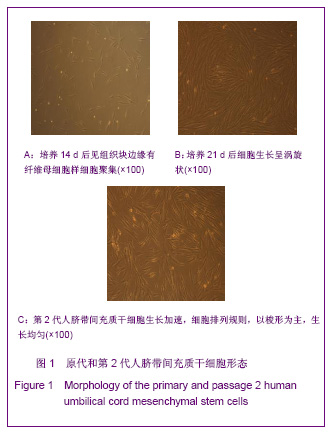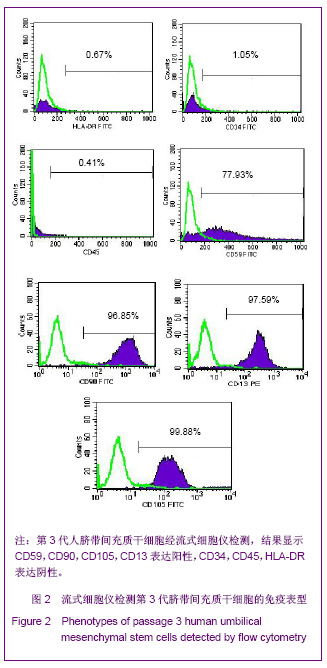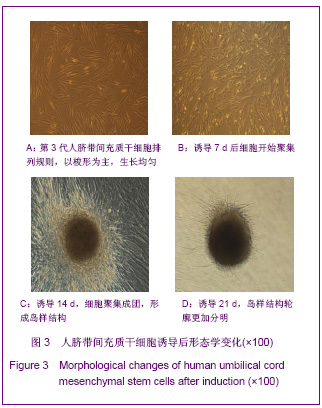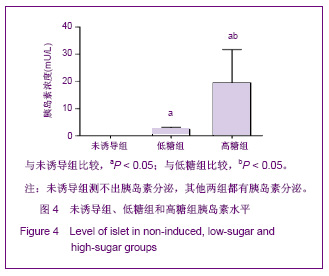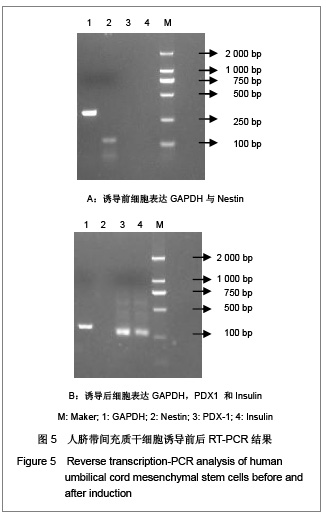| [1] Merani S, Shapiro AM. Current status of pancreatic islet transplantation. Clin Sci (Lond). 2006;110(6):611-625.[2] Sarugaser R, Lickorish D, Baksh D,et al. Human umbilical cord perivascular (HUCPV) cells: a source of mesenchymal progenitors. Stem Cells. 2005;23(2):220-229.[3] Fu YS, Cheng YC, Lin MY,et al. Conversion of human umbilical cord mesenchymal stem cells in Wharton's jelly to dopaminergic neurons in vitro: potential therapeutic application for Parkinsonism. Stem Cells. 2006;24(1): 115-124.[4] Weiss ML, Medicetty S, Bledsoe AR,et al. Human umbilical cord matrix stem cells: preliminary characterization and effect of transplantation in a rodent model of Parkinson's disease. Stem Cells. 2006;24(3):781-792.[5] Troyer DL, Weiss ML.Wharton's jelly-derived cells are a primitive stromal cell population. Stem Cells. 2008;26(3): 591-599.[6] Fong CY, Richards M, Manasi N,et al. Comparative growth behaviour and characterization of stem cells from human Wharton's jelly. Reprod Biomed Online. 2007;15(6): 708-718.[7] Fu YS, Cheng YC, Lin MY,et al. Conversion of human umbilical cord mesenchymal stem cells in Wharton's jelly to dopaminergic neurons in vitro: potential therapeutic application for Parkinsonism. Stem Cells. 2006;24(1): 115-124.[8] Weiss ML, Medicetty S, Bledsoe AR,et al. Human umbilical cord matrix stem cells: preliminary characterization and effect of transplantation in a rodent model of Parkinson's disease. Stem Cells. 2006;24(3):781-792.[9] Conconi MT, Burra P, Di Liddo R,et al. CD105(+) cells from Wharton's jelly show in vitro and in vivo myogenic differentiative potential. Int J Mol Med. 2006;18(6):1089-1096.[10] Karahuseyinoglu S, Cinar O, Kilic E,et al. Biology of stem cells in human umbilical cord stroma: in situ and in vitro surveys.Stem Cells. 2007;25(2):319-331.[11] Nishiyama N, Miyoshi S, Hida N,et al. The significant cardiomyogenic potential of human umbilical cord blood-derived mesenchymal stem cells in vitro.Stem Cells. 2007;25(8):2017-2024.[12] Lumelsky N, Blondel O, Laeng P,et al. Differentiation of embryonic stem cells to insulin-secreting structures similar to pancreatic islets. Science. 2001;292(5520):1389-1394.[13] Sun B, Roh KH, Lee SR,et al. Induction of human umbilical cord blood-derived stem cells with embryonic stem cell phenotypes into insulin producing islet-like structure. Biochem Biophys Res Commun. 2007;354(4):919-923.[14] Liu GL, Lu YF, Li WJ,et al. Differentiation of marrow-derived islet-like cells and their effects on diabetic rats.Chin Med J (Engl). 2010;123(22):3347-3350.[15] Phuc PV, Nhung TH, Loan DT,et al. Differentiating of banked human umbilical cord blood-derived mesenchymal stem cells into insulin-secreting cells. In Vitro Cell Dev Biol Anim. 2011; 47(1):54-63.[16] Chao KC, Chao KF, Fu YS,et al. Islet-like clusters derived from mesenchymal stem cells in Wharton's Jelly of the human umbilical cord for transplantation to control type 1 diabetes. PLoS One. 2008;3(1):e1451.[17] Ma L, Feng XY, Cui BL,et al. Human umbilical cord Wharton's Jelly-derived mesenchymal stem cells differentiation into nerve-like cells.Chin Med J (Engl). 2005;118(23):1987-1993.[18] Fu YS, Cheng YC, Lin MY,et al. Conversion of human umbilical cord mesenchymal stem cells in Wharton's jelly to dopaminergic neurons in vitro: potential therapeutic application for Parkinsonism. Stem Cells. 2006;24(1): 115-124.[19] Kadam SS, Tiwari S, Bhonde RR. Simultaneous isolation of vascular endothelial cells and mesenchymal stem cells from the human umbilical cord. In Vitro Cell Dev Biol Anim. 2009; 45(1-2):23-27.[20] Wang HS, Shyu JF, Shen WS,et al. Transplantation of insulin-producing cells derived from umbilical cord stromal mesenchymal stem cells to treat NOD mice. Cell Transplant. 2011;20(3):455-466.[21] Gao F, Wu DQ, Hu YH,et al. In vitro cultivation of islet-like cell clusters from human umbilical cord blood-derived mesenchymal stem cells.Transl Res. 2008;151(6):293-302.[22] Delacour A, Nepote V, Trumpp A,et al. Nestin expression in pancreatic exocrine cell lineages. Mech Dev. 2004;121(1): 3-14. |
